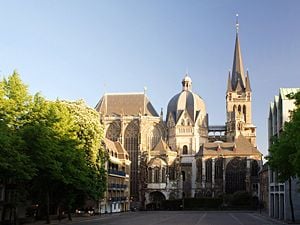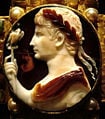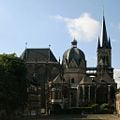Difference between revisions of "Aachen Cathedral" - New World Encyclopedia
David Doose (talk | contribs) m |
David Doose (talk | contribs) m |
||
| Line 14: | Line 14: | ||
'''Aachen Cathedral,''' frequently referred to as the "'''Imperial Cathedral'''" (in [[German language|German]]: ''Kaiserdom)'' is a [[Roman Catholic]] church in [[Aachen]], [[Germany]]. The church is the oldest [[cathedral]] in northern [[Europe]] and was known as the "'''Royal Church of St. Mary at Aachen'''" during the [[Middle Ages]]. For 600 years, from 936 to 1531, the Aachen chapel was the church of [[coronation]] for 30 [[List of German monarchs|German kings]] and 12 queens. | '''Aachen Cathedral,''' frequently referred to as the "'''Imperial Cathedral'''" (in [[German language|German]]: ''Kaiserdom)'' is a [[Roman Catholic]] church in [[Aachen]], [[Germany]]. The church is the oldest [[cathedral]] in northern [[Europe]] and was known as the "'''Royal Church of St. Mary at Aachen'''" during the [[Middle Ages]]. For 600 years, from 936 to 1531, the Aachen chapel was the church of [[coronation]] for 30 [[List of German monarchs|German kings]] and 12 queens. | ||
| − | The Cathedral of Aachen is one of the most famous examples of occidental architecture. It is the burial site of [[Charlemagne]] and a major pilgrimage site. The church has been the episcopal seat of the [[Diocese of Aachen]] since 1930. In 1978 it was the first German building to be included in the UNESCO World Heritage list. | + | The Cathedral of Aachen is one of the most famous examples of occidental architecture. It is the burial site of [[Charlemagne]] and a major pilgrimage site. The church has been the episcopal seat of the [[Diocese of Aachen]] since 1930. In 1978 it was the first German building to be included in the [[UNESCO]] World Heritage list. |
== Structure == | == Structure == | ||
Revision as of 20:55, 13 April 2009
| Aachen Cathedral* | |
|---|---|
| UNESCO World Heritage Site | |

| |
| State Party | |
| Type | Cultural |
| Criteria | i, ii, iv, vi |
| Reference | 3 |
| Region** | Europe and North America |
| Inscription history | |
| Inscription | 1978 (2nd Session) |
| * Name as inscribed on World Heritage List. ** Region as classified by UNESCO. | |
Aachen Cathedral, frequently referred to as the "Imperial Cathedral" (in German: Kaiserdom) is a Roman Catholic church in Aachen, Germany. The church is the oldest cathedral in northern Europe and was known as the "Royal Church of St. Mary at Aachen" during the Middle Ages. For 600 years, from 936 to 1531, the Aachen chapel was the church of coronation for 30 German kings and 12 queens.
The Cathedral of Aachen is one of the most famous examples of occidental architecture. It is the burial site of Charlemagne and a major pilgrimage site. The church has been the episcopal seat of the Diocese of Aachen since 1930. In 1978 it was the first German building to be included in the UNESCO World Heritage list.
Structure
Charles the Great (Charlemagne) began the construction of the Palatine Chapel around 792, along with the building of the rest of the palace structures.[1]
It was consecrated in 805 by Pope Leo III in honor of the Virgin Mary. The core of the Aachen cathedral is the Palatine Chapel which is surprisingly small in comparison to the later additions.
In order to sustain the enormous flow of pilgrims in the Gothic period a choir hall was built: a two-part Capella vitrea (glass chapel) which was consecrated on the 600th anniversary of Charlemagne's death. In 1978, it was one of the first 12 items to make the entry into the UNESCO list of world heritage sites, as the first German and one of the first three European historical ensembles.
Treasury
The Aachen cathedral treasury displays sacral masterpieces of the late Classical, Carolingian, Ottonian and Staufian period - among them there are some unique exhibits like the "Cross of Lothair" the "Bust of Charlemagne" and the "Persephone sarcophagus." The Cathedral Treasury in Aachen is regarded as one of the most important ecclesiastical treasuries in northern Europe.
Final Resting Place of Charlemagne
When he died in 814, Charlemagne was buried in a vault in the cathedral.
In 1000, Otto III had Charlemagne's vault opened. Otto of Lomello, one of the courtiers who accompanied him, recorded the event, which is reported in the Chronicle of Novalesia, written about 1026. The account reads:
So we went in to Charles. He did not lie, as the dead otherwise do, but sat as if he were living. He was crowned with a golden crown and held in his gloved hands a sceptre; the fingernails had penetrated through the gloves and stuck out. Above him was a canopy of limestone and marble. Entering, we broke through this. Upon our entrance, a strong smell struck us. Kneeling, we gave Emperor Charles our homage, and put in order the damage that had been done. Emperor Charles had not lost any of his members to decay, except only the tip of his nose. Emperor Otto replaced this with gold, took a tooth from Charles’s mouth, walled up the entrance to the chamber, and withdrew again.[2]
A large picture representing Otto and his nobles gazing on the dead Emperor was painted on the wall of the great room in the Town Hall.
In 1165, Emperor Frederick Barbarossa again opened the vault and placed the remains in a sculptured sarcophagus made of Parian marble, said to have been the one in which Augustus Caesar was buried. The bones lay in this until 1215, when Frederick II had them put in a casket of gold and silver. A vellum codex found interred with him was removed.
Shrine of the Virgin Mary
The Shrine of St. Mary rests in the choir of the church and dates from 1220-1239. Adorned with the figures of Christ, Mary, Charlemagne, Pope Leo III and the Twelve Apostles, the shrine contains the four great Aachen relics: St. Mary's cloak, Christ's swaddling clothes, St. John the Baptist's beheading cloth and Christ's loincloth. Following a custom begun in 1349, every seven years the relics are taken out of the shrine and put on display during the Great Aachen Pilgrimage. This pilgrimage most recently took place during June 2007.
Other burials
- Otto III, Holy Roman Emperor
Gallery
- AachenCathedral hb.JPG
Cathedral exterior
Throne of Charlemagne
Sarcophagus of Charlemagne
Reliquary bust of Charlemagne
Shrine of the Virgin Mary (1238)
- AachenerDomApsis.jpg
Stained glass windows (1414)
Notes
ReferencesISBN links support NWE through referral fees
- Carl, Alfred, Nikolas Funke, and Nina Neckenbürger. 2002. Aachen and Its Cathedral: Notes on the City and a Guide to its Centre. Aachen: Einhard. ISBN 3936342059
- Dickmann, Ines, Michael Imhof, and Richard Lindsay. 2005. Aachen City and Cathedral Guide. Petersberg: Imhof. ISBN 9783865680266
- Schmitz-Cliever-Lepie, Herta, Ann Münchow, Erich Stephany, Leo Hugot, Carole Steber, and Susanne Steber-Jacobs. 1986. The Treasury of the Cathedral of Aachen. Aachen (Germany): Chapter of the Cathedral. OCLC 38735496
- Stephany, Erich. 1989. Aachen Cathedral. S.l: s.n.]. OCLC 39666994
- World Heritage: Monumental Sites. 2003. Milano: Skira. ISBN 9231039199
External links
- Aachen Cathedral (Kaiserdom)
- Aachen Cathedral Guide
- World Heritage Site
- Aachen Cathedral website (in German)
- Cathedral Music
| |||||||
Coordinates:
Credits
New World Encyclopedia writers and editors rewrote and completed the Wikipedia article in accordance with New World Encyclopedia standards. This article abides by terms of the Creative Commons CC-by-sa 3.0 License (CC-by-sa), which may be used and disseminated with proper attribution. Credit is due under the terms of this license that can reference both the New World Encyclopedia contributors and the selfless volunteer contributors of the Wikimedia Foundation. To cite this article click here for a list of acceptable citing formats.The history of earlier contributions by wikipedians is accessible to researchers here:
The history of this article since it was imported to New World Encyclopedia:
Note: Some restrictions may apply to use of individual images which are separately licensed.











